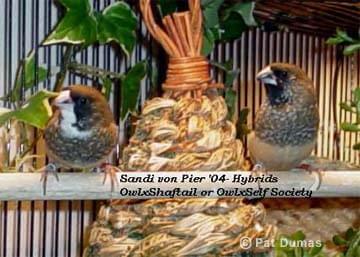Hybridization
-crossbreeds - mules - mutts-
by Myra
Articles and Information - Lady Gouldian Finch
Hybridization defined: To produce or cause to produce hybrids; crossbreed.
If the definition isn't working for you I'll explain it. A Hybrid is a finch (though this applies to all animals) that is produced from the pairing of two different species of finch. A rather common example is an Owl finch and Zebra finch pair. When bred together they produce an Owl/Zebra Finch Hybrid. The hybrid will exhibit traits of both the Zebra finch and the Owl finch. Often they literally look like a blend of the two species.
Hybrids do occur in the wild as well in aviary set-ups. There are rather significant flaws with hybrids, which is why I am against the idea of intentionally producing them.
Flaws:
Let's go to the wilderness first. While Hybrids do occur in nature they almost never develop into a viable species. The first major problem is that not all Hybrids work. Some species pairings simply will not produce young. They are far too genetically incompatible to produce a fertile egg.
If offspring are produced and they survive they are often sterile and would never be able to breed with any other finch no matter which species they attempt to mate with. Of course before they can mate they must attract a finch of the opposite sex. Attracting a mate isn't always an easy task for them. They don't look or sound entirely like one species or the other. The potential mates simply view them as another finch.
Looking unlike everyone else in the flock has broader complications than simply finding a mate. The coloring of finch species is used to attract a mate and to blend into the environment or confuse a predator. Because these Hybrids don't fit into either species they become extremely easy for a predator to spot and follow. If these finches survive to adulthood they have been very lucky.
 Hybrids - Photo by Pat Dumas
Hybrids - Photo by Pat Dumas
On top of it all, the Hybrids are a drain on the species gene pool. While their parents were producing them they aren't passing along their genes to young which would someday produce more. Many species of finch only breed once or twice a year. In many cases they have used their only breeding cycle for the year to produce these rather unique dead end babies. If something should happen to either or both of the parents before they can breed with their own species, that entire family line has been brought to a halt. If the gene pool becomes too small, inbreeding occurs.
The aviary and finch breeding community these hybrids aren't well received. Granted these birds are unique and often odd looking. However they have no value to a breeder. At best you may be able pawn some off on a novice finch keeper or someone who has no interest in breeding finches. A true finch breeder and fancier will probably never pay for a hybrid finch. They simply consume food and produce nothing seeing as most are sterile.
Hybrids are sometimes used to add color to a finch or alter its behavior. This is becoming quite popular in the European Goldfinch community. The European Goldfinch are crossed with Canaries to give them a more uniform look, more yellow, and improve their song. These birds are now simply refereed to as Mules. The practice has become so wide spread that many sellers of European Goldfinches at bird fairs must label their birds as Mules or Pure. Mules are worth almost nothing and the Pure are becoming very hard to find and expensive.
This is where the big problem with hybrids comes into play. European Goldfinch's aren't exactly a thriving market in many areas of the world. In places within the US they are even becoming hard to find and the prices are going up. The breeders who are exclusively producing these Mules aren't producing pure European Goldfinches. This is driving their price up and the available gene pool down at an alarming rate. European Goldfinches are still being imported into the US from other countries. This helps bring in new blood, but once the import is stopped we are going to be in trouble.
The export of many species from their native lands is now banned. The number of birds banned species is increasing yearly. There may well come a time when all the genetic diversity we have access to will be what's currently living in the USA. If too many breeders spend their time producing hybrids will we have terrible shortages. This can lead to inbreeding very quickly.
Good Points:
Acceptance of a hybrid into an established aviary isn't usually a problem. Finches either will get along with other species or they won't. It doesn't matter what the other finch looks like in most cases.
Hybrids while being infertile can be useful as foster parents. They are also good if you want to stock an aviary with unique looking and non-breeding finches. Best of all they are often cheap or free. As I stated earlier, they have no value in the finch trade. They are also not recognized by any serious finch organization. Sorry I'm leaking back towards the bad again.
The Society Finch:
Many believe the Society is the result of hybridization. Many others and myself now have their doubts about this. It has been argued that the species was created with the careful hybridization of the Striated Finch and the Indian Silverbill. A slightly more plausible idea is that the Society is simply a domestic version of the Striated Finch (White-rumped Mannikin). They do share some physical and behavioral features with the Society finch where as the Silverbill doesn't.
© lady gouldian finch.com 2017